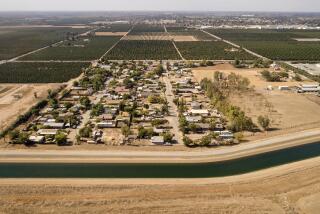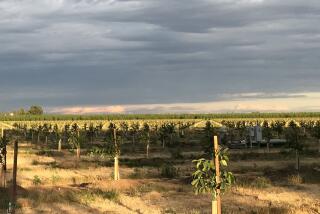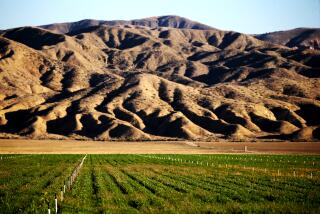Rancho Santa Fe’s top water users have cut down dramatically
Marty and Pamela Wygod occupy the highest echelons of California’s residential water customers, a group that has been demonized for weeks as resource hogs amid an epic statewide drought.
Most of the ignominy has been heaped on unidentified water users, such as the “Wet Prince of Bel-Air,” so named by the Center for Investigative Reporting because the city of Los Angeles would not reveal the name of its top water customer. “Drought posses” patrolled the streets of Bel-Air, trying to ascertain his identity, as officials sought ways to rein in the most prolific customers.
In Rancho Santa Fe, the top users have been easier to identify.
The Wygods were residential customer No. 1 for several years running. In 2003, they used about 57 million gallons on their estate — almost five times as much as the “Wet Prince.”
From that height, the Wygods have cut substantially, likely placing them among the top residential water conservationists in the state — in addition to the top users. In 2013, the Wygods’ consumption was down to around 28 million gallons, according to district records.
Marty Wygod, chairman of health information provider WebMD Health Corp., estimated that in the last quarter of this year, usage was down at least 50% compared to 2013, putting it closer to the 12-million-gallon annual draw of the “Wet Prince.”
“We’ve taken the lead in the state in the reduction of water consumption even though we have 109 acres, of which a large percentage is fruit trees or lemon groves,” Wygod said. “When we saw what was taking place with the [state’s] water shortage, we thought it was our responsibility to set the best example in the state.”
The water provider, known as the Santa Fe Irrigation District, has shielded the identities of its top customers recently. Officials used to publish their names annually, not as an exercise in “drought shaming” but as an obscure listing in the agency’s annual financial reports.
The Wygods have replaced the grass around their home and infinity pool with a drought-tolerant garden, and they’ve allowed large swaths of the estate to turn brown, Wygod said. They have installed a filtration system so they can use well water for irrigation.
“We’ve gotten special equipment in from Australia so 50% to 60% of usage is well water,” Wygod said. “We’ve got equipment that filtrated out the bad elements in the water so it wouldn’t hurt the fish or the birds.”
Extensive groves of lemon trees surrounding the house continue to receive drip irrigation, but Wygod said he’s prepared to remove them if they become unsustainable.
The couple recently applied for and received an agricultural exclusion, so some of the water they use for the groves wouldn’t be subject to mandatory cutbacks. Wygod said it’s all drip irrigation and described the amount of excluded water as negligible. The well water also is excluded from the irrigation district’s accounting of each customer’s usage.
Another top residential water customer identified in district reports was professional golfer Phil Mickelson. According to public records, he lives on a residential property that includes a private golf course.
Mike Barron, property manager for the 22-acre estate, said the practice facility is mostly natural grass and covers about 4 acres. The homeowner has been watering the course as little as possible, but hasn’t gotten rid of it because he needs it for his livelihood, Barron said.
“It’s really hard for him to be out practicing anywhere else, because he can’t get any work done,” Barron said. “He opted to put the facility here five years ago, just to have some quiet time to concentrate on his game.”
Barron said the estate invested heavily to conserve and reuse water throughout the property, which has allowed him to meet conservation goals while still keeping the course “up to par.”
Recent improvements, including a system to purify well water for irrigation, additives to reduce evaporation from the swimming pool and drought-tolerant landscaping, have helped bring total annual water usage down to about 6.1 million gallons from about 13 million gallons last year.
Barron is letting 8 acres of the property return to its natural state, and he’s “letting go” of some of the 180 lemon trees.
“We’ve got a lot of people involved, and we strive to do the right thing. But at the end of the day, it is a practice facility on that side of the property,” Barron said.
Cook writes for the San Diego Union Tribune.
More to Read
Start your day right
Sign up for Essential California for news, features and recommendations from the L.A. Times and beyond in your inbox six days a week.
You may occasionally receive promotional content from the Los Angeles Times.






